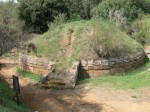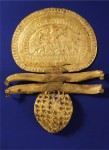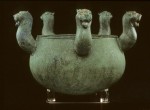 Two new museum exhibits dedicated to Etruscan culture, one at the University of Amsterdam’s Allard Pierson Museum (APM), the other at the National Museum for Antiquities (RMO) in Leiden, will debut what looks like a brilliant digital 3D reconstruction of the Regolini-Galassi tomb in Cervetri.
Two new museum exhibits dedicated to Etruscan culture, one at the University of Amsterdam’s Allard Pierson Museum (APM), the other at the National Museum for Antiquities (RMO) in Leiden, will debut what looks like a brilliant digital 3D reconstruction of the Regolini-Galassi tomb in Cervetri.
 The Regolini-Galassi tomb dates to the 7th century B.C. and was discovered in 1836 by General Vincenzo Galassi and the archpriest of Cervetri, Alessandro Regolini. Within they found at least two burials in four chambers — a lavishly adorned woman of royal status in the end cell, ashes in a bronze funerary urn in the right chamber — and evidence of one more — a bronze bed in the antechamber next to a chariot indicating a warrior burial.
The Regolini-Galassi tomb dates to the 7th century B.C. and was discovered in 1836 by General Vincenzo Galassi and the archpriest of Cervetri, Alessandro Regolini. Within they found at least two burials in four chambers — a lavishly adorned woman of royal status in the end cell, ashes in a bronze funerary urn in the right chamber — and evidence of one more — a bronze bed in the antechamber next to a chariot indicating a warrior burial.  They also found an amazing wealth of precious artifacts, elaborate furnishings, silverware, gilded and bronze vessels decorated with lions and griffins, and immense golden pectoral pieces and a golden disc fibula which had once covered the body of the princess.
They also found an amazing wealth of precious artifacts, elaborate furnishings, silverware, gilded and bronze vessels decorated with lions and griffins, and immense golden pectoral pieces and a golden disc fibula which had once covered the body of the princess.
The 300 artifacts discovered in the Regolini-Galassi tomb are now on display at the Vatican Museum, but the tomb itself, poorly conserved after Messrs Galassi and Regolini emptied it out and left to the elements, is no longer open to the public. Enter Etruscanning 3D, a collaborative project supported by the APM, RMO, the Gallo-Roman Museum in Tongeren, Belgium, CNR-ITABC (a research institute that uses new technology in the preservation of cultural patrimony), Visual Dimension in Ename, Belgium, plus the Vatican Museum and the Villa Giulia in Rome, which seeks to digitize Etruscan tombs so museum visitors can experience them as they were when first discovered.
The team began by laser scanning the tomb in June of this year. They then compared the current data with maps, sketches and reports from the original 19th century excavation to pinpoint as closely as possible the precise location of objects in the tomb. Next they spent three days at the Vatican laser scanning the artifacts from the tomb. Computer graphics and GIS data were then employed to recreate a 3D rendering of the tomb.
The coolest part, though, is how the digital rendering was developed into a user-friendly interface for the museum exhibits. The visitor stands in front of a large screen. On the floor is a map of the Regolini-Galassi tomb. The user walks on the map moving a virtual camera which displays the reconstruction of that area of the tomb on the screen. There are seven “hotspots” on the map. When the user stands on a hotspot, a narration describes all the artifacts found on that spot.
Sadly, the narration appears to be in Dutch only at this point, but at least you can catch a glimpse of the reconstructed tomb experience in this YouTube video:
[youtube=http://www.youtube.com/watch?v=cj7NuW6Uc3Q&w=430]
Etruscans: Women of Distinction, Men of Power, the double exhibit at the Allard Pierson Museum and National Museum for Antiquities has been conceived as a diptych, APM focusing on the role of men in Etruscan society while the National Museum focuses on Etruscan women. The exhibits opened on October 14 and will close in March of 2012. After that, they are scheduled to move to the partner Italian museums.